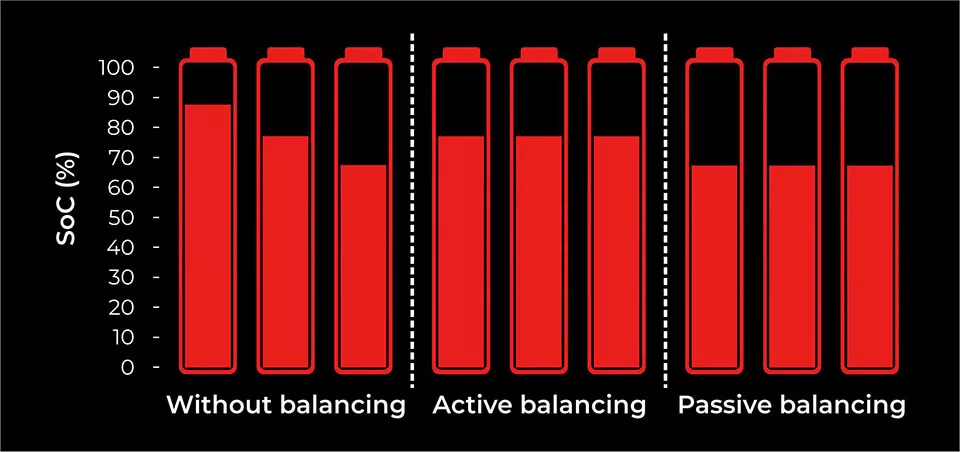Cell balance is a state in which all the individual cells in have the same capacity and voltage. While connecting the lithium-ion cell in series and parallel, the maker ensures they are of the same voltage and chemistry. Once the battery pack is installed and subjected to charging and discharging, the individual cells’ voltage values tend to vary, causing cell imbalance over a period. Parallel cells balance each other naturally with a mutual voltage, so cell balancing is not a concern for parallel cell battery packs. On the other hand, cell balancing plays a crucial role on the performance of a battery pack wherein the multiple cells are in series.
The weakest cell, among the series cells, determines the battery pack’s overall capacity. In cell balancing, battery redistribution is done to improve the battery pack’s overall potential, improve the cell’s longevity, and make all of the pack’s energy available.
During cell imbalance, cells of a battery pack generally have variable capacities and are at different state-of-charge (SoC) levels. In the absence of any cell balancing or without redistribution, discharging of the pack will stop when the cell with the lowest capacity is empty or the overall battery capacity of the pack equals the weakest cell in the battery pack. Thus an undercharged series cell will cause the entire pack to have less lifetime. During charging, the higher voltage cell will reach a full charge and will trip the battery gauge, not allowing the lower charged cells to charge fully. These are undesirable situations as they lead to the underutilization of the total potential of the pack. The differences in the internal resistances of cells, their capacity, cell temperatures, repeated charging/discharging cycle with voltage equalization and ageing characteristics leads to a cell imbalance situation.
Types of Cell Balancing
Active Cell Balancing
During active cell balancing, energy/charge transfers from a higher voltage to a lower voltage cell within the battery using an internal circuit using charge-storing components like capacitors and inductors. Figure 1 shows that during charging, the middle cell with the highest SoC transfers energy to other cells with lower SoC to ensure that the charging does not stop without charging the entire cells of the pack to their full capacity.
 Figure 1: Active Cell Balancing During Charging
Figure 1: Active Cell Balancing During Charging
As shown in Figure 2, the higher SoCs cell transfers energy to the lowest SoC cell during discharging, ensuring that no unused energy in the pack is left and the packs work for longer durations.

Figure 2: Active Cell Balancing During Discharging
Active Cell Balancing is a speedy process that improves battery efficiency and enhances life expectancy. However, during energy transfer among cells, there could be some loss of energy (10-20%). Active balancing requires a more complex and larger footprint solution.
Passive Cell Balancing
Burning off the excess energy from the higher energy cells till it matches the one with the lowest voltage or energy cell in the pack is a process of passively balancing the cell. With the use of a resistor the excess voltage is dissipated as heat. In this each cell in series has its own bypass resistor connected through a switch like MOSFET. Figure 3 depicts this phenomenon.

Figure 3: Passive Cell Balancing
Passive balancing is a less preferred method as it burns off excess energy, resulting in lower efficiency. This method does not offer any improvement in battery run time. However, it is a low-cost method with no energy wastage during balancing.



Leave A Comment